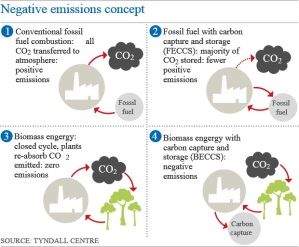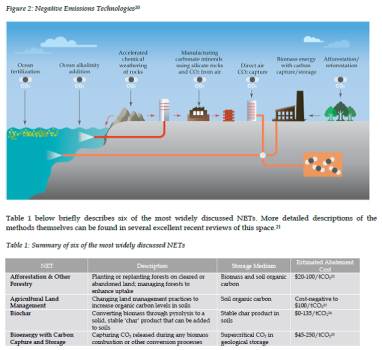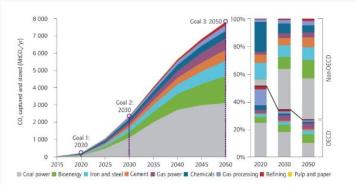Expectations of a climate change agreement in Paris this year were ‘brightsided’ by Christiana Figueres’ vision of a carbon free planet, but in 2100 not 2050.
It has taken over a year for the IPCC 5th A.R. Report to be digested and spread from the science into the policy sphere, and in front of us is pure science fiction.
The energy policy sector is centred on the International Energy Authority and their insistence that Carbon Capture and Storage (CCS) will enable a “negative emissions” technology to dominate emissions generation post 2050.
The cat has slowly been let out of the bag since February this year when the Guardian reported :
“EU climate chief and UN’s top climate official both play down expectations that international climate talk pledges will help hit 2C target”.
 “The European Union climate chief, Miguel Arias Canete, says talks at a major climate summit in Paris this year will not be a failure even if governments fail to keep warming below the dangerous 2C threshold”
“The European Union climate chief, Miguel Arias Canete, says talks at a major climate summit in Paris this year will not be a failure even if governments fail to keep warming below the dangerous 2C threshold”
The recent comments by Figueres amplify that;
“The overwhelming consensus is that Paris 2015 needs to send an unequivocal signal that the world will take a path towards a steep and deep decline in greenhouse gas pollution by the second half of the century.”
The ramifications of the IPCC 5th A.R. report are only just being ‘teased out’, there is a new era dawning, “the Anthropocene”, and the solutions now advocated are suitably heavily reliant on Geo engineering, Negative Emissions Technology, intellectual arrogance, hubris and science fiction.
“Stranded Carbon Assets and Negative Emissions Technologies, a Working Paper” Oxford University.
So we have a technology based IPCC future where the interim years will be the last thrashings of a dying economic system attempting to scour every last $ from the planet’s resources before 2050.
In the process the ‘mythical carbon budget’ becomes a toy for the use of the fossil fuel industry. If an 80% + chance of staying under 2 degrees is chosen, and equity remains a guiding principle, then ALL the carbon budget is allocated to Non Annex 1 countries.
The “Great White Hope” or great white elephant.
ALL IPCC RECOMMENDED emissions reduction progress is based on the continued development of carbon capture and storage. The development programme designed by the IEA shows the 22 established CCS projects up and running or under construction, to be in line with the IEA forecast of 30 plants by 2020. Capturing and storing 40 million tonnes of carbon underground, 0.1% of the 40 BILLION tonnes emitted this year.
HOWEVER, the fact that in 16 of the plants the liquid carbon is being used to pressure pump oil out of hitherto “spent oil wells” makes a farce of CCS being regarded as ‘emissions free’. Even now CCS is regarded as only being 85% efficient so there are fugitive emissions from the process, and a big Uranium sized “storage” question mark.
“In order to explain the extent of the requisite effort I have been using a revealing comparison. Let us assume that we commit initially to sequestering just 20 percent of all CO2 emitted from fossil fuel combustion in 2010, or about a third of all releases from large stationary sources. After compressing the gas to a density similar to that of crude oil (800 kilograms per cubic meter) it would occupy about 8 billion cubic meters—meanwhile, global crude oil extraction in 2010 amounted to about 4 billion tonnes or (with average density of 850 kilograms per cubic meter) roughly 4.7 billion cubic meters.
This means that in order to sequester just a fifth of current CO2 emissions we would have to create an entirely new worldwide absorption-gathering, compression-transportation- storage industry whose annual throughput would have to be about 70 percent larger than the annual volume now handled by the global crude oil industry whose immense infrastructure of wells, pipelines, compressor stations and storages took generations to build.
Technically possible—but not within a timeframe that would prevent CO2 from rising above 450 ppm.”
http://www.vaclavsmil.com/wp-content/uploads/docs/smil-article-2011-AMSCI.11.pdf
The staggering growth of the IEA’s CCS industry ‘visioning’, by 2030 it hopes to be storing 2 gigatons of CO2, out of 40+ gigatons.
“By 2050, CCS is routinely used to reduce emissions from all applicable processes in power generation and industrial applications at sites around the world, with over 7 000 MtCO2 annually stored in the process.”
IEA. Technology Roadmap. Carbon Capture and Storage. P24.
“The IPCC sees CCS capturing as much as 60,000 million tonnes in 2100, a scale 15 times that of the world’s current oil industry. ” http://www.carbonbrief.org/blog/2014/10/around-the-world-in-22-carbon-capture-projects/
“Various trends make deep emissions reduction unlikely. There is a lack of global political consensus on the most appropriate strategies to reduce emissions, and we are locking ourselves into a long-lived energy system fuelled mostly by coal, oil and gas. At the same time global population continues to rise, as does the expectation of a higher standard of living – especially in rapidly developing countries pursuing a perfectly equitable growth agenda.
These points lead us to an uncomfortable conclusion: we are already at risk of failing to meet a target that is itself inadequate to avoid dangerous climate change. Against this backdrop of increasingly challenging news, what are our options?”
Many eminent scientists are calling for very deep emissions reductions immediately, whilst a growing part of the “environmental lobby” support a reliance on technology. Time however may cut that short.
The basic mathematics of emissions generation and “the carbon budget” are very simple.
* The atmosphere contains over 400 ppm CO2. The temperature has risen at least 0.8C.
* 2 degrees temperature increase is accepted as 450 ppm CO2. This is not a “safe” target
* The world is currently emitting 2 / 2.5 ppm CO2 in the atmosphere every year. 40 Gigatons.
* In 20 years’ time, (i.e. 2035), at current emissions levels, the atmosphere will contain the level of CO2 to exceed 2 degrees of warming.
What do we know?
1/ China will not peak emissions until 2030, it has a large CCS contribution projected.
2/ India has not completed its INDC, but is talking of a doubling of coal consumption. India’s emissions are not expected to peak until 2045.
3/ Africa, South America, Asia are not expected to peak emissions until 2060
4/ Governments of Annex 1 countries are doing all they can to preserve the “trickle down” neo liberal theory of “sustainable development”.
5/ Western Industrialised Nations need to cut their emissions generation 80% under 1990 levels by 2030 to allow the Non Annex 1 countries what little there is left of the “carbon budget”. Part of the “climate Justice” reparations and principles of “equity”.
6/ The “postponement” of deep emissions reductions until post 2050 (when it is expected that CCS will be fully proven and tested), allows the complete saturation of the core of the earth, down to a level of 1 kilometre, with poisonous liquid carbon. As well as the pernicious cocktail “mainlined” into immediate subsurface through “fracking”.
7/ All Western Industrialised countries are going gangbusters for Bio Mass renewable energy. All emissions reduction strategy used by the IPCC to arrive at under 2 degrees rely heavily on Bio Mass combustion (Bio Energy > B.E). and Carbon Capture and Storage BECCS).
8/ CCS technology, (negative emissions) is regarded as “the silver bullet” precisely because it can “suck carbon out of the atmosphere”, should there be a failure in emissions reductions targets.
The IEA admits,
“The largest challenge for CCS deployment is the integration of component technologies into large-scale demonstration projects. Lack of understanding and acceptance of the technology by the public and some stakeholders also contribute to delays and difficulties in deployment.”
NO large scale demonstration project exists, CCCS may NEVER be proven as safe OR possible, at scale, and yet incredibly, the future of UNFCCC and IPCC emissions reductions strategies relies on CCS.
With the increasing likelihood of there being a carbon budget overshoot, such global ‘net negative emissions’ may be required to actively reduce atmospheric GHG concentrations to safer levels. However, while this type of large scale removal of CO2 may eventually be required, there are two reasons why hoping to reach emissions targets via such an overshoot trajectory is a dangerous alternative to timely mitigation.
First, there are serious limitations to our ability to predict technological and social development over subsequent decades, and thus, the feasibility of large scale deployment in the future.
Neglecting to reduce emissions now on the assumption that NET’s can recapture emissions in future would be dangerous if NET deployment on the required scale could not then be realised.
There are also significant dangers of passing tipping points, such as the dieback of the Amazon Rain Forest or the rapid collapse of the Greenland Ice Sheet, that increase of CO2 levels rise. Once alternative Earth System States have been realised, the system may not return to where it originally started if CO2 concentrations are then reduced.
One thing is certain – without viable Carbon Capture and Storage, large scale post 2050 Negative Emissions Technologies, or Carbon Budget increases, will NOT be available.
It is clear that very large-scale negative emissions deployment, if it were possible, is not in any sense preferable to timely decarbonisation of the energy and agricultural systems.
“Stranded Carbon Assets and Negative Emissions Technologies, a Working Paper” Oxford University. Feb 2015.







Hi Richard, thanks for taking the time to write this, confirms what I suspected. Frightening. Louisa x